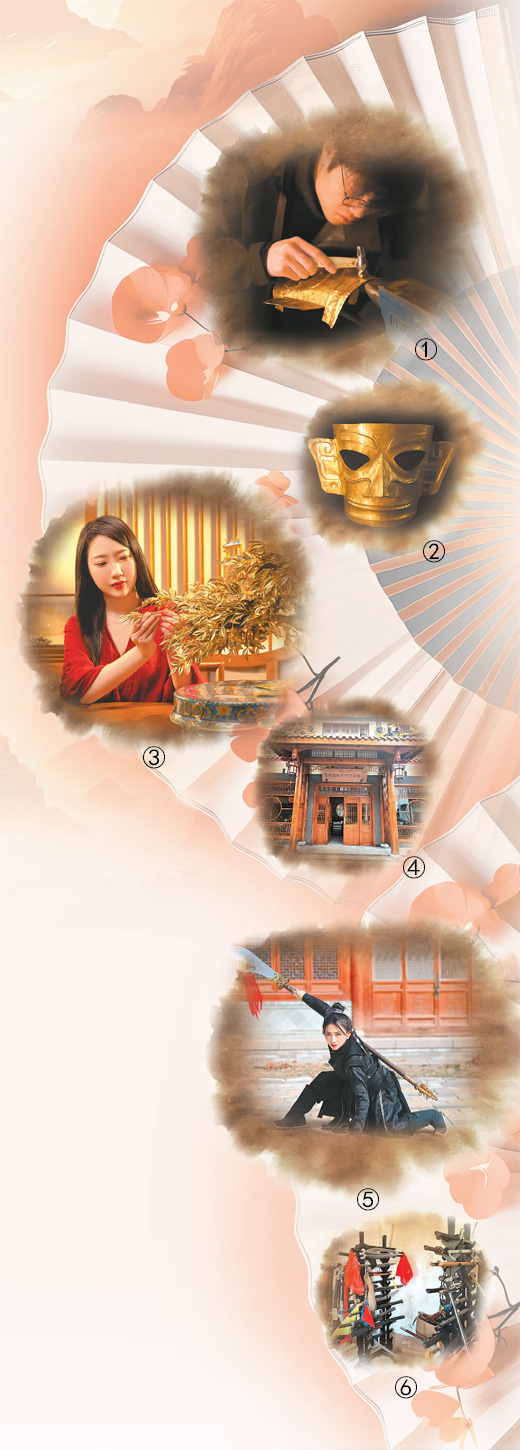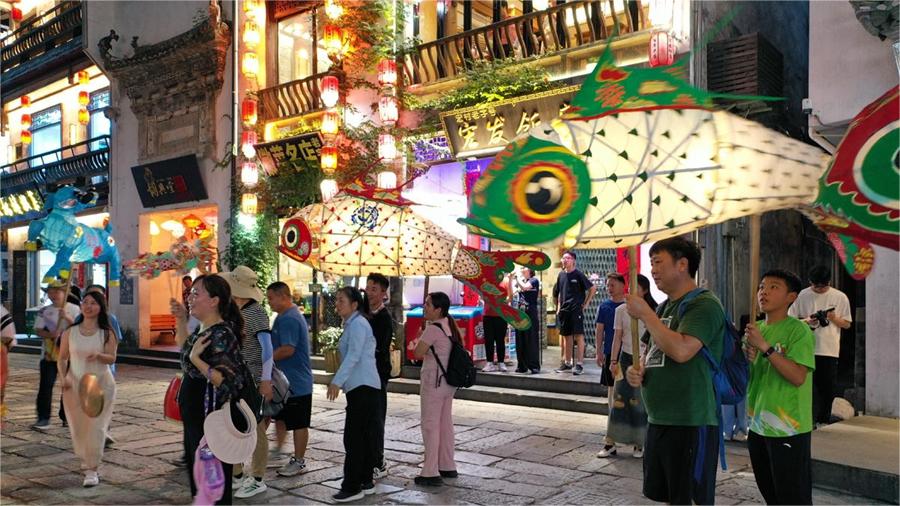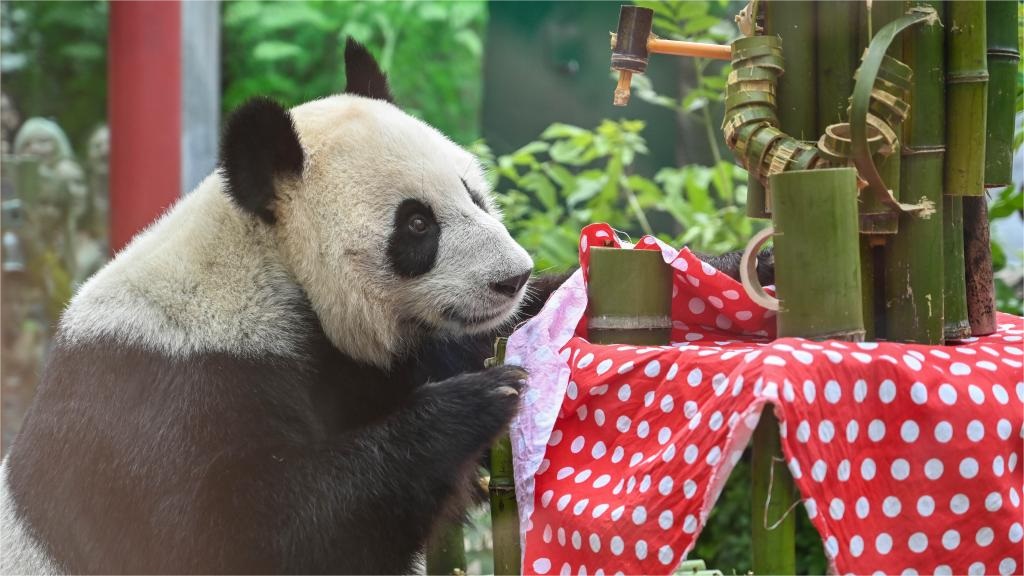Young Chinese vloggers breathe new life into traditional culture
Traditional martial arts, folk music, opera, intangible culture heritage crafts… In recent years, China has witnessed a significant surge in the popularity of traditional culture among its youth.
Data released by the country's popular video sharing platform Bilibili showed that a total of 7.45 million traditional Chinese style-themed videos were posted on the platform last year, attracting 220 million viewers.
Many young content creators are enthusiastic about showcasing the traditional culture of China. Three such content creators shared their stories.

①: Wang Xinge, a young vlogger in China, makes a replica of an ancient gold mask, based on a fragment of a gold mask unearthed at the famous Sanxingdui Ruins in southwest China's Sichuan Province. (Photo courtesy of Wang Xinge)
②: A replica of an ancient gold mask handmade by Wang Xinge, a young vlogger in China. (Photo courtesy of Wang Xinge)
③: Yan Hong, a Chinese vlogger known for handmaking exquisite accessories of traditional Chinese style, displays one of her works. (Photo courtesy of Yan Hong)
④: A workshop where visitors can experience filamentary silver hovering art under the guidance of veteran artisans. The workshop is operated by Yan Hong, a Chinese vlogger known for making exquisite accessories of traditional Chinese style, and several other inheritors of filamentary silver hovering art, which has been recognized as one of China's national-level intangible culture heritages. (Photo courtesy of Yan Hong)
⑤: Zhang Hanliang, a Chinese martial arts vlogger, makes a video to showcase martial arts to netizens. (Photo courtesy of Zhang Hanliang)
⑥: Weapon props used by Zhang Hanliang, a Chinese martial arts vlogger, for shooting videos. (Photo courtesy of Zhang Hanliang)
Young handicraft enthusiast brings ancient artifacts to life
Wang Xinge, a vlogger who has an ardent passion for traditional Chinese culture and handicrafts, has accumulated millions of followers on Bilibili for sharing videos of handmaking replicas of precious museum artifacts.
His first video that went viral was about a 3,000-year-old gold mask.
In March 2021, archaeologists unearthed new artifacts at the Sanxingdui Ruins, located in southwest China's Sichuan Province. The ruins, considered "one of the world's greatest archaeological finds of the 20th century", contained an artifact that particularly intrigued Wang, a fragment of a gold mask.
"I saw it on the news. It looked awe-inspiring and solemn. It was also mysterious, as it was only a fragment, a half of a mask," Wang recalled. He began to wonder what it may have looked like when it was first created thousands of years ago.
Driven by this curiosity, Wang decided to recreate the mask himself, documenting the process on video. He bought 500 grams of gold, which cost him over 200,000 yuan (about $27,605.62), and spent 15 days meticulously hammering the precious metal into shape.
There were many difficulties during the creation process, especially hammering the curved shape of the mask without breaking it. The original artifact being only a fragment of the mask was also a challenge, and Wang had to consult academic resources to get an idea of how to craft the missing parts.
"It was like a dialogue across time. I felt as if I was experiencing the journey of an ancient craftsman from 3,000 years ago. It was magical," Wang said.
The video of Wang's gold mask recreation went viral, inspiring him to start a new video series centered on ancient artifacts. He has since recreated various ancient artifacts, including a gold scepter, a three-legged pottery cooking vessel unearthed at Sanxingdui, and a crystal cup from the Warring States Period (475-221 B.C.).
The video series has garnered over 30 million views on Bilibili alone.
"People usually see these treasures behind glass in museums, which is still not close enough," Wang said, adding that by showing people the process of recreating them, viewers are allowed to imagine how these objects might have been born.
"It's like taking those national ‘treasures' out of museums and bringing history within reach," he said.
Ingenious stylist integrates intangible cultural heritage into accessories
Yan Hong, a popular vlogger well-known for her videos of making exquisite traditional Chinese style accessories out of simple materials such as aluminum cans, twisting sticks, cardboard boxes, and nutshells, is now an artisan committed to preserving and carrying forward crafts of intangible cultural heritage.
Initially a stylist providing makeup and styling services for weddings, Yan started making her own accessories to complement her designs. Since many of her peers and friends requested to learn how to make the beautiful accessories, she began sharing her creative process online.
With her videos gaining more and more attention, Yan was surprised to find that many young netizens are interested in intangible cultural heritage techniques and traditional handicrafts.
She then shifted the focus of her work to sharing videos of her creations and dug deeper into traditional handicrafts.
Eager to improve her skills, Yan sought out Ni Chengyu, a master craftswoman in Chengdu, capital of Sichuan, to learn filamentary silver hovering art. The craft has been recognized as one of China's national-level intangible cultural heritages.
Under the tutelage of Ni, she transformed from an enthusiast into a true inheritor of this ancient craft, and began combining it with contemporary designs, creating pieces that appeal to young fashion enthusiasts.
Her most prized creation is a "half-face makeup" headdress inspired by a popular illustrator's work, which took three years to perfect.
While an increasing number of fans began to follow Yan's work, she had another goal in mind: establishing a team dedicated to the inheritance of filamentary silver hovering art.
Ni, who passed away over a year into Yan's studies, expressed her hope that Yan could organize a team to better pass on the intangible cultural heritage.
In March 2023, Yan fulfilled her late master's wish by establishing a team dedicated to carrying forward the filamentary silver hovering art. She has also opened a workshop with several other artisans of filamentary silver hovering art. The workshop allows visitors to experience the art form firsthand.
"From being influenced by the nationwide craze for traditional Chinese style to becoming an inheritor of intangible cultural heritage, I've benefited greatly," Yan said. "I believe more and more young people will continue to spread our excellent traditional culture."
Female martial artist showcases charm of Chinese martial arts
Zhang Hanliang, known to her 8 million followers as a "real-life female warrior," is bringing traditional Chinese martial arts to a global audience through her captivating videos.
Born into a family of doctors and martial artists, Zhang learned martial arts from her father and elder brother when she was young. At the age of 8, she enrolled in a sports school and began training with the martial arts team.
Despite the rigorous training and painstaking practice, she persevered with her choice, believing that her dedication would eventually bear fruit.
"Although it was hard, the experience honed my willpower, strengthened my body, and enriched my life," Zhang said.
As her skills improved, Zhang won championships in various martial arts competitions, including swordplay, spearplay, and Taijiquan (Tai Chi).
After becoming a teacher in the School of Physical Education and Health, Tianshui Normal University, Zhang pondered how to better preserve and promote traditional Chinese martial arts. She began by sharing snippets of her training online, which quickly gained traction.
Her breakthrough came with a four-minute video of her showcasing 26 types of traditional Chinese cold weapons, like swords, spears and whips. The video went viral.
"Traditional martial arts have many schools that make use of numerous different weapons," Zhang said. "Knowledge of some weapons are preserved and passed down well, while some are almost lost. Considering that people rarely have the opportunity to learn more about these traditional weapons, I wanted to showcase them through videos and help viewers understand the charm of Chinese cold weapons in the shortest time possible."
Creating these videos is no easy feat. Zhang often has to learn new weapons from scratch and may repeat a single move 40 to 50 times to capture the perfect shot. Her most popular video, titled "Chinese Kung Fu," took a month to film and edit.
Her videos have been widely praised, with many netizens commenting that her moves are both beautiful and powerful.
Zhang patiently replies to various comments on her videos, explaining that traditional martial arts encompass multiple systems and that modern practice is often focused on health and fitness rather than combat.
"In recent years, public understanding of traditional martial arts has been improving," Zhang said. "The number of martial arts training institutions is growing, bringing traditional martial arts closer to everyday life."
Looking ahead, Zhang hopes to continue spreading Chinese martial arts culture, especially to overseas audiences. "I hope to sow the seeds of traditional Chinese martial arts culture in every corner of the world," she said.
Photos
Related Stories
- The exquisite silver ornaments of the Miao ethnic group
- Traditional culture given a modern twist
- Digital humans become new 'messengers' of traditional Chinese culture
- Pic story: inheritor of traditional string-weaving technique in NE China's Jilin
- Going digital for going popular -- Tech empowers traditional Chinese culture
- Young artist dedicated to passing down the craft of tongcao flowers making
Copyright © 2024 People's Daily Online. All Rights Reserved.









